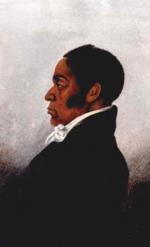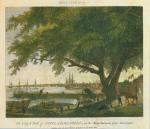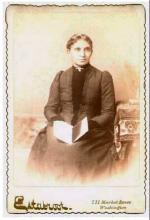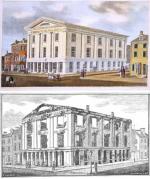![header=[Marker Text] body=[A wealthy sailmaker who employed multi-racial craftsmen, Forten was a leader of the African-American community in Philadelphia and a champion of reform causes. The American Antislavery Society was organized in his house here in 1833.] sign](http://explorepahistory.com/kora/files/1/10/1-A-28C-139-ExplorePAHistory-a0h9f1-a_450.jpg)
Mouse over for marker text
Name:
James Forten
Region:
Philadelphia and its Countryside/Lehigh Valley
County:
Philadelphia
Dedication Date:
April 24, 1990
Behind the Marker
With a population of 44,000 in 1790, Philadelphia was the largest city in the United States. It was also home to more than 1,800 free blacks, the largest community of its kind on the eastern seaboard. Caught in a precarious position between slavery and freedom, some members of the free black community were still able to share in the economic opportunities of the early republic.
James Forten offers a fine example of a free black entrepreneur who took advantage of the business opportunities that came his way, channeled them into a considerable fortune, and used his wealth to further the abolitionist cause.
Born in Philadelphia to free black parents in 1766, Forten at the age of eight began working alongside his father in Robert Bridges" sail loft. The death of his father forced Forten to find additional work to support his family. Somehow his mother still found a way to send him part-time to a Quaker school for two years.
At the age of fourteen, Forten volunteered for service in the Revolutionary War. Assigned to the Royal Lewis, a privateer that supported the Continental Navy, he worked various posts, including powder boy and sailor. Captured by the British on his second cruise, he escaped sale into slavery in the West Indies by winning the friendship of the British captain, who made Forten a companion for his young son. Choosing imprisonment rather than allegiance to Britain, Forten then spent seven long months on a British prison ship. Freed in a prisoner exchange in 1782, he returned to Philadelphia, and to a mother and sister who had both believed him dead.
After the war, Forten spent a year working in shipyards and sail lofts along the River Thames in England. Returning to Philadelphia, he rejoined Robert Bridges" sail loft as an apprentice sailmaker, and rose steadily through the ranks. In 1798 Bridges decided to retire and asked the thirty-two-year-old Forten to remain in charge of the loft. He then loaned him enough money to purchase the business. Within three years Forten owned it outright.
Forten had been experimenting with different types of sails for many years. By the early 1800s he had invented one that enabled ships to maneuver more adeptly and to maintain greater speeds. Although he did not patent the sail, he was able to benefit financially, as his sail loft became one of the most successful and prosperous in Philadelphia.
Independence from Great Britain had freed American merchants from the trade restrictions of the British mercantile system - although not from harassment on the high seas by England, France, and the Barbary pirates of the Mediterranean. In the decades that followed, merchant vessels built and berthed in Philadelphia sailed the oceans of the world, bringing their owners great fortunes - and promising even greater riches in the fabled China Trade. With the fortune of a lifetime riding on a single voyage, merchants needed the very best sails and rigging - no matter what the race of the maker.
In the early 1800s Forten presided over an integrated workforce of at times more than thirty men, who obeyed his strict rules of hard work, church attendance, abstention from alcohol, and strict punctuality. At times he noted sarcastically that although legally entitled to vote, he was prevented by whites from exercising this right, but it didn't matter: his white workers voted as he directed to advance their mutual economic interests. A shrewd investor, he bought up houses and land in Philadelphia and the surrounding region, purchased stock in the Mount Carbon Rail Company, and made loans to a variety of local businessmen - both black and white.
Forten's fortune was considerable for any man, black or white. While Forten had a luxurious life-style, he also used his financial resources for humanitarian causes. He used more than half of his wealth to purchase the freedom of slaves, finance William Garrison's abolitionist newspaper, The Liberator, operate an Underground Railroad station out of his home on Lombard Street, and fund a school he had opened for black children in his house.
Forten worked closely with other antislavery leaders, such as Richard Allen and Absalom Jones, and was a founding member of the Free African Society and the American Reform Society. Vocal in his opposition to slavery, he was also active in other reform causes, particularly women's rights and temperance, and was involved in almost every major civic event concerning the African-American community in Philadelphia from the 1790s until his death in 1842. After waffling on the question of colonization - a popular plan to resettle free blacks in Africa - he became a firm opponent of the American Colonization Society, founded in 1816, and refused offers that he set an example by leaving the country.
Free African Society and the American Reform Society. Vocal in his opposition to slavery, he was also active in other reform causes, particularly women's rights and temperance, and was involved in almost every major civic event concerning the African-American community in Philadelphia from the 1790s until his death in 1842. After waffling on the question of colonization - a popular plan to resettle free blacks in Africa - he became a firm opponent of the American Colonization Society, founded in 1816, and refused offers that he set an example by leaving the country.
The Forten women were also prominent activists. In 1833, James" wife Charlotte Vandine Forten and their three daughters helped to found the Philadelphia Female Anti-Slavery Society, the first integrated women's abolitionist organization. Two daughters, Harriet and Sarah, married the brothers Joseph and Robert Purvis, respectively, and spoke out in favor of abolition and black suffrage. Margaretta, the third daughter, supported the women's rights movement and taught school for over thirty years.
Robert Purvis, respectively, and spoke out in favor of abolition and black suffrage. Margaretta, the third daughter, supported the women's rights movement and taught school for over thirty years.
As a successful African-American businessman and civic leader, James Forten for many years personified the American Revolution's ideals of equality and opportunity. In the early 1800s, however, race relations in Pennsylvania, as elsewhere in the nation, deteriorated. In the state's 1838 constitution African-American men lost the right to vote in Pennsylvania; at the same time, slave catchers from the South terrorized free blacks, and competition for jobs and housing in Philadelphia led to hostility and then violence.
Forten received repeated threats on his life, and in 1834 young white toughs attacked and almost killed his son on the streets of Philadelphia. As King Cotton reinvigorated slaveholding in the American South, the promise of economic opportunity and social harmony between the races in Pennsylvania gave way to restricted economic opportunities and loss of the rights and privileges of citizenship.
James Forten offers a fine example of a free black entrepreneur who took advantage of the business opportunities that came his way, channeled them into a considerable fortune, and used his wealth to further the abolitionist cause.
Born in Philadelphia to free black parents in 1766, Forten at the age of eight began working alongside his father in Robert Bridges" sail loft. The death of his father forced Forten to find additional work to support his family. Somehow his mother still found a way to send him part-time to a Quaker school for two years.
At the age of fourteen, Forten volunteered for service in the Revolutionary War. Assigned to the Royal Lewis, a privateer that supported the Continental Navy, he worked various posts, including powder boy and sailor. Captured by the British on his second cruise, he escaped sale into slavery in the West Indies by winning the friendship of the British captain, who made Forten a companion for his young son. Choosing imprisonment rather than allegiance to Britain, Forten then spent seven long months on a British prison ship. Freed in a prisoner exchange in 1782, he returned to Philadelphia, and to a mother and sister who had both believed him dead.
After the war, Forten spent a year working in shipyards and sail lofts along the River Thames in England. Returning to Philadelphia, he rejoined Robert Bridges" sail loft as an apprentice sailmaker, and rose steadily through the ranks. In 1798 Bridges decided to retire and asked the thirty-two-year-old Forten to remain in charge of the loft. He then loaned him enough money to purchase the business. Within three years Forten owned it outright.
Forten had been experimenting with different types of sails for many years. By the early 1800s he had invented one that enabled ships to maneuver more adeptly and to maintain greater speeds. Although he did not patent the sail, he was able to benefit financially, as his sail loft became one of the most successful and prosperous in Philadelphia.
Independence from Great Britain had freed American merchants from the trade restrictions of the British mercantile system - although not from harassment on the high seas by England, France, and the Barbary pirates of the Mediterranean. In the decades that followed, merchant vessels built and berthed in Philadelphia sailed the oceans of the world, bringing their owners great fortunes - and promising even greater riches in the fabled China Trade. With the fortune of a lifetime riding on a single voyage, merchants needed the very best sails and rigging - no matter what the race of the maker.
In the early 1800s Forten presided over an integrated workforce of at times more than thirty men, who obeyed his strict rules of hard work, church attendance, abstention from alcohol, and strict punctuality. At times he noted sarcastically that although legally entitled to vote, he was prevented by whites from exercising this right, but it didn't matter: his white workers voted as he directed to advance their mutual economic interests. A shrewd investor, he bought up houses and land in Philadelphia and the surrounding region, purchased stock in the Mount Carbon Rail Company, and made loans to a variety of local businessmen - both black and white.
Forten's fortune was considerable for any man, black or white. While Forten had a luxurious life-style, he also used his financial resources for humanitarian causes. He used more than half of his wealth to purchase the freedom of slaves, finance William Garrison's abolitionist newspaper, The Liberator, operate an Underground Railroad station out of his home on Lombard Street, and fund a school he had opened for black children in his house.
Forten worked closely with other antislavery leaders, such as Richard Allen and Absalom Jones, and was a founding member of the
The Forten women were also prominent activists. In 1833, James" wife Charlotte Vandine Forten and their three daughters helped to found the Philadelphia Female Anti-Slavery Society, the first integrated women's abolitionist organization. Two daughters, Harriet and Sarah, married the brothers Joseph and
As a successful African-American businessman and civic leader, James Forten for many years personified the American Revolution's ideals of equality and opportunity. In the early 1800s, however, race relations in Pennsylvania, as elsewhere in the nation, deteriorated. In the state's 1838 constitution African-American men lost the right to vote in Pennsylvania; at the same time, slave catchers from the South terrorized free blacks, and competition for jobs and housing in Philadelphia led to hostility and then violence.
Forten received repeated threats on his life, and in 1834 young white toughs attacked and almost killed his son on the streets of Philadelphia. As King Cotton reinvigorated slaveholding in the American South, the promise of economic opportunity and social harmony between the races in Pennsylvania gave way to restricted economic opportunities and loss of the rights and privileges of citizenship.








